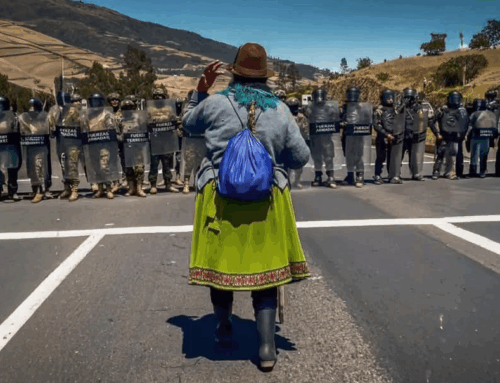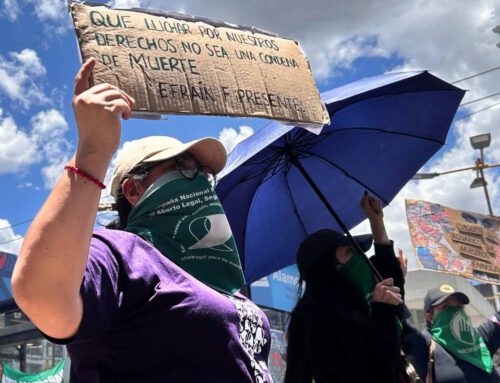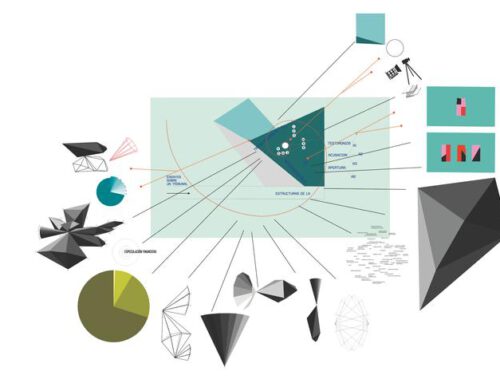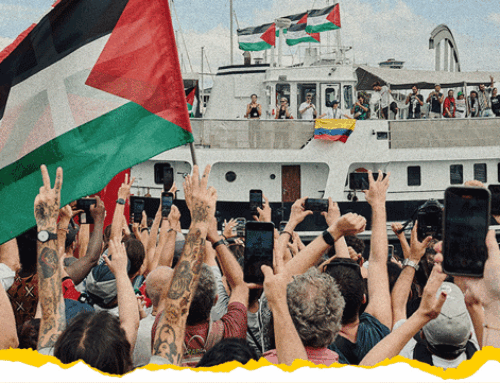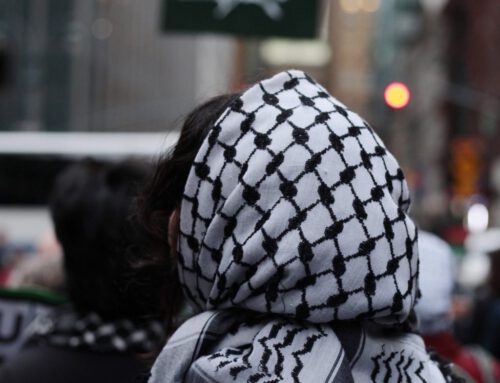Betty Ruth Lozano Lerma
Originally published in Spanish in Desinformémonos. English translation by Liz Mason-Deese
“Even the Cops are Becoming Hit Men”
Cali, May 9, 2021
“The government is killing us” is the cry of SOS issued by Colombian youth in the face of the repression unleashed by the government against the peaceful mobilization that started April 28, the day a national strike was called by all the country’s union federations. The population took to the streets in massive night and that night a wave of police violence was unleashed against protesters who had established permanent blockades in strategic points of the city, attacking them with bullets in order to generate terror and discourage protest.
Did someone say fear?
Despite the fact that the repression continued in following days, it only caused the indignation to increase, which lead to an unprecedented multitude taking to the streets in Cali on May Day, with dignified rage rising to the surface. However, the National Strike Committee had only called for a one-day strike on April 28 and for virtual protest actions on International Workers’ Day. What has happened is that the Committee is no longer making the decisions about the protests, the young men and women in the blockades have created their own decision-making and organizational bodies.
President Iván Duque Márquez’s government is treating legitimate protest guaranteed by the constitution as a war. Duque has given the army command in what is already a self-coup, deploying disproportionate military force against young people who are only armed with their dreams and rocks.
As of this writing, on May 8, the numbers of human rights violations already correspond to those of a country under a military dictatorship. Under the framework of “military assistance,”1 the government claims to maintain public order through force. The police, ESMAD2, the army, and armed civilians (paramilitaries) have attacked the blockades with live fire and declared the Voluntary Medical Mission that attends the wounded at those blockades to be a military target, in clear violation of international human rights standards.
It is already impossible to count the number of people murdered and disappeared, the beaten and the tortured, the number women sexually abused by the police. The military forces and police are impeding human rights defenders from carrying out their work. There are no guarantees for life in Colombia today.
The Campaña Defender la Libertad’s [Campaign to Defend Freedom] Informational Bulletin Number 9 details the human rights violations over the nine days of the national strike, from April 28 to May 7 (4:50pm), in the whole national territory:
- 451 people wounded by the disproportionate action of the National Police, particularly by ESMAD. 32 people suffered eye injuries; 32 people were injured by fire arms; 67 human rights defenders were harmed in the context of the mobilizations.
- 15 people were victims of gender-based violence by the police and ESMAD.
- 1,291 people have been arrested, many of them through arbitrary procedures, subjected to torture and/or cruel and inhuman treatment.
- 12 raids, of which 8 were declared illegal, including the resulting seizures. The remaining four are still being investigated.
- 629 reports of abuse of power, authority, aggression, and police violence.
- 32 people have died as a result of the action of public forces and/or unidentified civilian officers during the protest, as has one police officer [According to INDEPAZ, 47 people have been killed in the context of the National Strike between April 28 and May 8 (8:15pm), of which 39 were caused by police violence.
- 216 people have been disappeared in the context of the protests. We have received 258 reports of disappeared persons, of which there is information about 42 of those. However, the numbers could be higher, reports from the Working Table on Forced Disappearance in Colombia state that there could be up to 471 disappeared persons. [In Cali alone, there are reports of 125 disappeared persons between April 28 and May 6 (Misión de Verificación Valle)].
Despite this situation, young men and women stay on the streets, demonstrating how much has been taken away from them, to the point that they have even lost their fear. Their protests have been peaceful, creative, playful, artistic. There is more than sufficient evidence that the police are carrying out acts of vandalism and violence to delegitimize protests, reduce their popularity, and justify the use of state force. Those who are mobilizing today know that the government lies.
What caused the protests?
The antecedents to this strike go back to November 2019 (21N), when protests were called by union federations, social, peasant, Indigenous, and Afro-descendent organizations. Young people were also on the front lines of those protests, that time university student organizations. The night of November 21 saw the creation of an environment of fear with rumors of illegal armed groups led by foreigners, who were allegedly behind the strike and that moved throughout the city attempting to enter people’s homes and residential complexes to loot and other outrages. It was the government trying to create a scene of terror to justify the action of the state’s repressive forces.
The protests on November 21, 2019 were massive, as had never before been seen in the country. The majorities were waking up to the precarization of life, at all levels, due to the neoliberal model. That strike become a topic of national debate, supported by beauty queens, singers, and different figures from the entertainment sector. We were following the path of Peru, Ecuador, Chile, and Bolivia, and according to former president Uribe and his governing party, the Centro Democrático, the strike was a strategy by the Sao Paolo Forum to destabilize Latin American democracies.
The population mobilized against what was referred to as “Duque’s paquetazo”: a series of proposed economic measures that were seen as a show of the success of the president’s administration by the ruling party. Those measures included labor reform: a 75% reduction in the minimum wage for young people under the age of 25, differentiated according to the specific region’s productivity and hiring of hourly personnel; tax reform: tax breaks for large companies and multinational corporations; financial reform: privatization of the productive apparatus of the state and the state financial sector through Holding; pension reform: increasing the retirement age and privatizing public pension funds (Colpensiones), among other unpopular measures. People also marched in favor of the implementation of the peace agreement signed with the FARC in 2016 and against corruption.
At that time, the National Strike Committee presented a total of 13 demands to the government, including dissolving ESMAD and purging the police, as well as rejecting the proposals in the paquetazo.
The government’s reactions against the 21N strike were similar to some of those that it is deploying against the current strike: militarization of certain areas of the country, border closures, raids, quartering the army under maximum alert and granting extraordinary powers to certain local governors to “maintain the order” and use police repression. There were many reports of policy brutality, such as the beating that police officers inflicted on a woman in Bogota, leaving her unconscious. That act was captured on a video that went viral. In the context of the protests, the 18 year old student Dilan Cruz was killed by a projectile that hit him in the head, shot by an ESMAD captain.
Other acts that exacerbated the Colombian population’s dignified rage were the deaths of at least eight people under the age of 18 (some media reported up to 18 deaths) in an army operation against a guerrilla encampment of FARC dissidents in 2019. Among the victims were a 12 year old girl, a 16 year old girl, and a 15 year old boy. The government had only spoken of an impeccable military operation, but the truth was revealed in Congress and ended up costing defense minister Guillermo Botero his job. That minister had already received international attention when the New York Times revealed that he had ordered the military to double the number of “criminals and guerrillas” that they killed, captured, or forced to surrender in combat.
This brought to the fore the issue of the so-called “false positives,” the name given to the victims of extrajudicial executions by members of the army. During the government of Uribe Vélez, young people were kidnapped from their homes or tricked and led away, murdered and later dressed up as guerrillas to be counted as casualties in combat to show that the struggle against the insurgency was yielding results. The JEP (Special Jurisdiction for Peace) revealed that the number of extrajudicial executions was triple that which was previously thought, totalling 6402 young people, but that number could rise even higher as investigations are still ongoing. Uribe lied to the country saying that the government was winning the war against the FARC, showing how many guerrillas had been killed, when in reality they were young people from the popular sectors who had been tricked under the pretext of a job, being paid to play soccer or going to pick coffee in rural areas. All of those criminal lies have come to light.
Another, no less important, antecedent of the protests can be found in the systematic murder of social leaders, human rights defenders, demobilized former FARC fighters, massacres in Afro-descendant and Indigenous regions with particular strategic interests, forced displacements, threats, disappearances, and feminicides:
According to Magistrate Cifuentes, the assassination of social movement leaders has been increasing since the signing of the Final Peace Accord, adding up to 904. According to the risk Monitoring System Report, 334 threats of death, 99 homicide attempts, 32 forced displacements, 31 kidnappings, 13 disappearances, and 12 massacres have been documented between 2016 and 2020. Regarding former FARC combatants, the JEP [Special Jurisdiction for Peace] president warned that there have been 276 homicides between December 1, 2016 and February 28, 2021. Of those, 253 were against people who had appeared before the Special Jurisdiction.
Neither the government nor other state institutions have provided effected responses to this situation.
Among the women murdered defending their territories the cases that have had the most resonance are those of two Indigenous governors and an Afro-descendant leader who was shot in front of her 9-year-old son by motorcycle hit men. That was the case of María del Pilar Hurtado, 34 years old, murdered on June 21, 2019 in Tierra Alta, Cordoba. She was a native of Puerto Tejada, a Black town, which she left due to threats against her life. The Indigenous governor of the Tacueyó reservation, 29-year-old Cristina Bautista Taquinas was murdered on October 29, 2019, along with four Indigenous guards in an attack that left at least five other people injured. On April 20 of this year, 38-year-old Indigenous governor Sandra Liliana Peña Chocué, in El Porvenir in La Laguna Siberia reservation, in the municipality of Caldono. The events took place in an Indigenous territory that has been militarized by the state and is experiencing an exacerbation of the war four years after the signing of the Peace Accords.
The conjuncture of the pandemic rendered visible and deepened the precarization of life. All the informal work that people do has been acting as a cushion for the crisis but it has become very difficult to sustain. Domestic workers, for example, cannot go out to work and many have lost their jobs. Street vendors were persecuted by the police for not respecting the confinement measures, while large chain stores remained open. It has been said that, of countries in the region, Colombia has had the third worst management of the pandemic, following Brazil and Mexico. The government has implemented economic projects that have further enriched bankers and big businesses, while increasing the impoverishment of the majority. According to the National Statistics Board (DANE), about 42% of the population now lives in poverty. Out of the 21 million people in poverty in the country, 7.4 million live in extreme poverty. In February of this year, 886,000 people were unemployed, increasing the number to a total of 3.9 million people who have no way of satisfying their basic needs. An enormous number of small businesses have gone bankrupt, while banks had profits of around 9 billion pesos. In Colombia, the people most susceptible to Covid are not the elderly, but the most impoverished. Along with all of this, there is also the corruption that robs us of more than 50 billion pesos annually.
The Protagonists: Young Women and Men
The strike that began on April 28 and that continues to this day, has largely been led by young people, especially from the most peripheral, marginalized, and impoverished parts of the city. These are not university students, but rather those who have not had the opportunity to study nor do they have the chance of decent employment (in the ILO’s terms).
It is the generation that was born during these 40 years of a neoliberal economy in Colombia, that has to live day by day because there is no way to dream or to build a future. These young people have placed themselves on what is called the front line in the strike’s concentration points and blockades, defending the blockades with their own lives. They account for the majority of the deaths. This is a youth that is full of frustration, when they wanted to study, it was impossible; when they tried to go out and work, they could not find jobs. They are the No Future generation. They have to make a living through informal work, without contributing to benefits or social security, many of them clean windshields at stoplights experiencing daily humiliations. At home, they are lacking everything. One young person on the front lines confessed that he had never eaten as well as he had during the strike, when collective community organization has been deployed, especially women of another generation on the third line, assisting with food, water, and first aid.
This is also the generation that has most directly experienced the economic and emotional consequences of the pandemic: their parents’ unemployment, their own unemployment, situations of stress due to enclosure and poverty. But it is also the generation of instantaneous communication through social media. Despite these painful situations, it is a generation that does not give up, that is still going out onto the streets today to lead the social change necessary so that they can have a dignified life, a life worth living.
The marches are made up of young women and men, all types of collectives, artists (in fact one of those murdered by ESMAD was 21-year-old Nicolás Guerrero, an urban artist who was participating in a candle light vigil for the fallen, who was killed by a bullet to the head, broadcast live), women, LGBTQI groups, teachers, students, housewives, soccer fan clubs, Afro communities, Indigenous peoples, the unemployed, informal workers. The whole country has taken to the streets in rage and, in response, has only received repression and death from the government.
What are we asking for?
Below I transcribe the statement issued following an assembly on the Universidad del Valle campus on May 6:
“The delegations of the meeting points and blockades, social, political, youth, student, artist, urban, rural, Afro, Indigenous, union, and workers’ movements and parties, the Departmental Strike Command, and others, gathered on May 6 in Auditorium 5 of the Universidad del Valle, declare:
1. The National Strike and its social and political mobilization in Cali, Valle and Colombia are due to an explosion of popular discontent as a result of years of exclusion and inequality, exacerbated by the Uribista dictator in power, whose criminal tax reform was only the spark that ignited popular indignation.
2. We recognize that there is no unified leadership to the strike, instead there are multiple social, political, and popular expressions in all the points of concentration and blockades. We need a directed and organized articulation.
3. We are issuing a warning that Duque’s government is attacking the strike, not only with an escalated criminal military response, but also by atomizing it with dialogues that divide sectors.
4. We call for the establishment of a humanitarian corridor for food, health and medical supplies, hygiene and sanitation elements, for provisioning basic services needed for survival, etc.
5. We denounce the misinformation campaign against the causes of and participants in the national strike, that the Uribe-Duque dictatorship and the military leaders blame on guerrilla fractions, vandals, and criminal gangs, and even on a supposed hidden international communist agenda.
6. We reject the criminal and complicit behavior of Mayor Ospina and Governor Roldán in allowing the repression and “military assistance” against legitimate social and popular protest, handing over their functions as local and regional authorities to the military leadership under Defense Minister Molano.
7. We call for popular assemblies in all the concentration points and blockades, culminating in a large national municipal assembly that would construct a single programmatic and democratic road map.
8. We demand that Iván Duque’s government establish the first negotiation talks in the city of Cali.
List of Social, Political, and Unitary Demands
1. Withdraw the “military assistance and escalation” from Cali and Cauca.
2. Guarantee the right to protest and social mobilization in the context of the National Strike.
3. Reform the police and dismantle the ESMAD.
4. Implementation of the peace accord and guaranteeing a stop to the murder of social and political leaders.
5. The renunciation of Armed Forces General Commander, Zapateiro.
6. Withdraw the health care, pension, and labor reforms.
7. A universal basic income and no fees for secondary and higher education.
8. Economic aid to small and medium-sized business and debt forgiveness.
9. Free education, and bio-safe conditioning for school to be held in person.
10. Invest more funds in basic, middle, and higher education.
11. Day and night nurseries for young children.
12. Investigative and criminal justice for all those murdered, injured, tortured, and disappeared during the National Strike.
13. No political and military persecution of the members and participants in the National Strike.
14. Creation of a truth clarification commission.
15. That Mayor Ospina and Governor Roldán apologize for their order to militarize the city and department and for their complicit and criminal behavior in handing over their functions as authorities to the military leadership.
16. That all detainees be immediately released and the immediate appearance of all the disappeared.
Strike to Advance! Long Live in the National Strike!
We don’t know what the outcome of the strike will be, our greatest fear, as one of the signs declared, is that, after the uprising, everything remains the same. We trust that it will not. We will continue walking.



